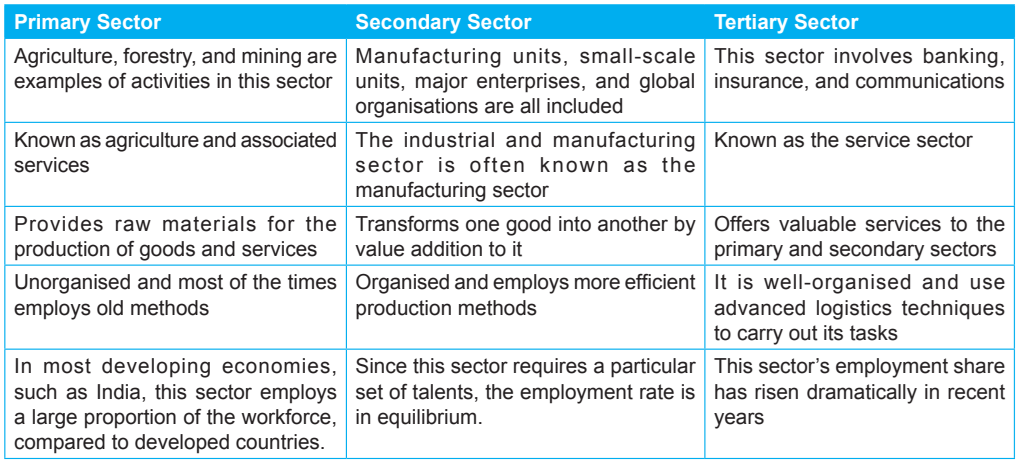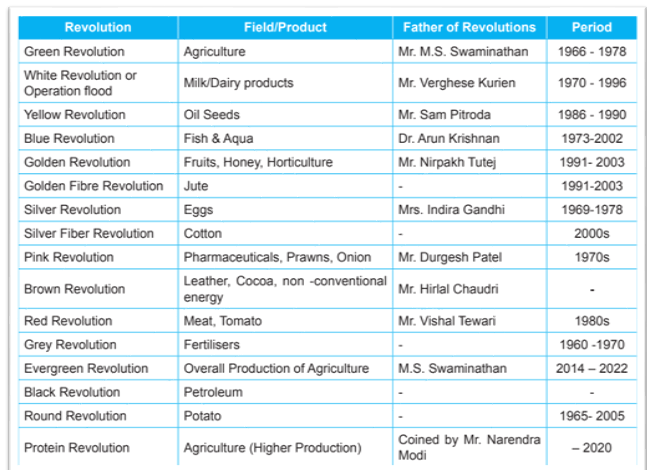Chapter 3 - Sectors of the Indian Economy
What we will learn ?
- Role & Importance of Primary, Secondary, Tertiary Sector, Quaternary & Quinary Sectors
- Difference between the sectors
- Different Revolutions in Primary sector
- GDP contribution of different sectors
- Agriculture
- Industry
- Services
- Employment growth rate in Secondary sector
- Sunrise Sector of Indian Economy
- Organised and Unorganised sectors
Role & Importance of Primary, Secondary, Tertiary Sector, Quaternary & Quinary Sectors
Primary Sector
This sector includes all those economic activities where there is the direct use of natural resources as agriculture, forestry, fishing, fuels, metals, minerals, etc. An agrarian economy exists when the agriculture sector (one of the key sectors) provides at least 50 per cent of a country’s national revenue and livelihood. Primary sector constitutes (a) agriculture, (b) forestry, and (c) fishing
Secondary Sector
It includes all economic activities that involve the processing of raw materials extracted from the primary sector also called industrial sector. Manufacturing, one of its sub-sectors, has proven to be the largest employer in the Western developed economies. An industrial economy is one, in which, the secondary sector generates at least half of a country’s national GDP and employment.
Tertiary Sector
This sector includes all economic activities that produce services, such as education, healthcare, banking, communication, and so on. A service-based economy exists when this sector generates at least half of a country’s national income and livelihood. Along with these 3 main sectors, the quaternary and quinary sectors have been introduced. In a broader sense, they are tertiary sector subsectors.
Quaternary Sector
Also known as the ‘knowledge’ sector. This category includes activities such as teaching, research, and development. The sector is by far the most important in assessing the strength of an economy’s human resources. The intellectual aspect of the economy is represented by the quaternary sector. This group includes employees in office buildings, elementary schools and university classrooms, hospitals and physicians’ offices, theatres, accountancy and brokerage businesses, and so on.
Quinary Sector
It includes activities in which key choices are made. It includes the highest level of decision makers in governments (including their bureaucracy) and the private corporate sector. The number of people participating in this sector is quite small, yet they are regarded the “brain” behind an economy’s socioeconomic performance. This group includes occupations such as senior company executives, government officials, research scientists, financial and legal advisors, and others.
Difference between the sectors

Different Revolutions in Primary sector

GDP contribution of different sectors
Contribution of different sectors to the economy by percentage
Year | Agriculture & Allied | Industry | Services |
1950-51 | 51.8 | 14.2 | 33.3 |
1960-61 | 42.6 | 19.3 | 38.3 |
1970-71 | 42.0 | 20.5 | 37.2 |
1980-81 | 35.4 | 24.3 | 39.9 |
1990-91 | 29.0 | 26.5 | 44.2 |
2000-01 | 23.0 | 26.0 | 51.0 |
2010-11 | 18.2 | 27.2 | 54.6 |
2019-20 | 18.3 | 26.9 | 54.8 |
2020-21 | 20.0 | 26.9 | 53.1 |
2021-22 | 18.6 | 28.6 | 52.8 |
Agriculture
- Agriculture has always been the most significant sector in India. It is not only the largest sector, but also the biggest private sector. This is the main unorganised sector of the economy, accounting for more than 90 per cent of all unorganised labour
- Below is extract of Government of India Report of 2020-21 by Ministry of Agriculture & Farmers’ Welfare “Agriculture plays a vital role in India’s economy. 54.6% of the total workforce is engaged in agricultural and allied sector activities (Census 2011) and accounts for 17.8% of the country’s Gross Value Added (GVA) for the year 2019-20 (at current prices). Given the importance of the agriculture sector, Government of India has taken several steps for its development in a sustainable manner. Steps have been taken to improve the income of farmers. Further, to mitigate risk in the agriculture sector, a scheme ‘Pradhan Mantri Fasal Bima Yojana’ (PMFBY) was also launched in 2016. Schemes such as Formation & promotion of 10,000 FPOs & the Agriculture Infrastructure Fund have also been launched recently to benefit the sector.”
Industry
- The industrial sector is equally vital, since it promotes economic growth, provides self-sufficiency and employment, generates demand for agricultural commodities and produces a ‘ripple effect.’ India’s industrial sector is divided into four sub-sectors namely i. Mining and quarrying ii. Manufacturing iii. Power, Gas, Water supply, and other utility services, and iv. Construction.
- The journey of Indian industry is quite interesting and can be summed up into four phases including both pre-reform and post-reform period.
- Phase I (1951–1965): The period of industrial foundation
- Phase II (1965–1980): The period of industrial fall
- Phase III (1980–1991): The period of industrial recovery
- Phase IV (1991 onwards): The post-reform period.
Services
- The sector produces ‘intangible or invisible goods’ for businesses as well as consumers. Trade, repairs, hotels and restaurants, transport, storage, communication and broadcasting services, railways, road transport, water transport, air transport, services incidental to transport, storage, financial, real estate, and professional services are all sub-sectors of the services sector.
- The services sector’s proportion has increased from 33 per cent in 1950 to 53 per cent in 2021-22.
- As per the findings of the Ministry of Statistics and Programme Implementation (MoSPI), in the year 2019-20, the share of the Service Sector in GVA was 55.3%, with break-up as follows-18.3% from Trade, hotels, transport, communication and services related to broadcasting; 21.4% from financial, real estate & professional services Public; and 15.6% from public administration, defence & other services.
Employment growth rate in Secondary sector
- Manufacturing employs roughly 12 per cent of the labour force.
- The construction sector is the second largest employment sector in the country, only after agriculture. Construction activity is an essential component of a country’s industrial and infrastructure growth, as well as a key input for socioeconomic development. This sector provides significant employment and growth input to other sectors via backward and forward linkages.
- The construction industry employs over 31 million people and accounting for around 8 per cent of total employment.
Sunrise Sector of Indian Economy
- The sector is often characterised by strong growth rates, a high degree of innovation, and a high level of public awareness, with investors attracted to its long-term growth prospects.
- Green Energy, Fintech, Information Technology, Electronics, Pharmaceuticals, Automobiles, Healthcare, Infrastructure Sector, Retail Sector, Processing Plants, and other emerging sectors of the Indian economy are part of the Sunrise Sector.
Organised and Unorganised sectors
Organised sector
- It is a sector where the employment terms are fixed and regular, and the employees get assured work.
- Governed by Various acts like Factories Act, Bonus Act, PF Act, Minimum Wages Act, etc.
- Government rules Strictly followed
- Regular monthly salary
- Job security
- Fixed Working Hours
- Examples: Government employees, registered industrial workers, etc.
Unorganised sector
- The unorganised sector is characterised by small and scattered units, which are largely not registered with the government.
- Not governed by any act
- Government rules Not strictly followed
- Daily wages
- No Job security
- Not Fixed Working Hours
- Examples: Shop keeping, Farming, Domestic works, etc.
